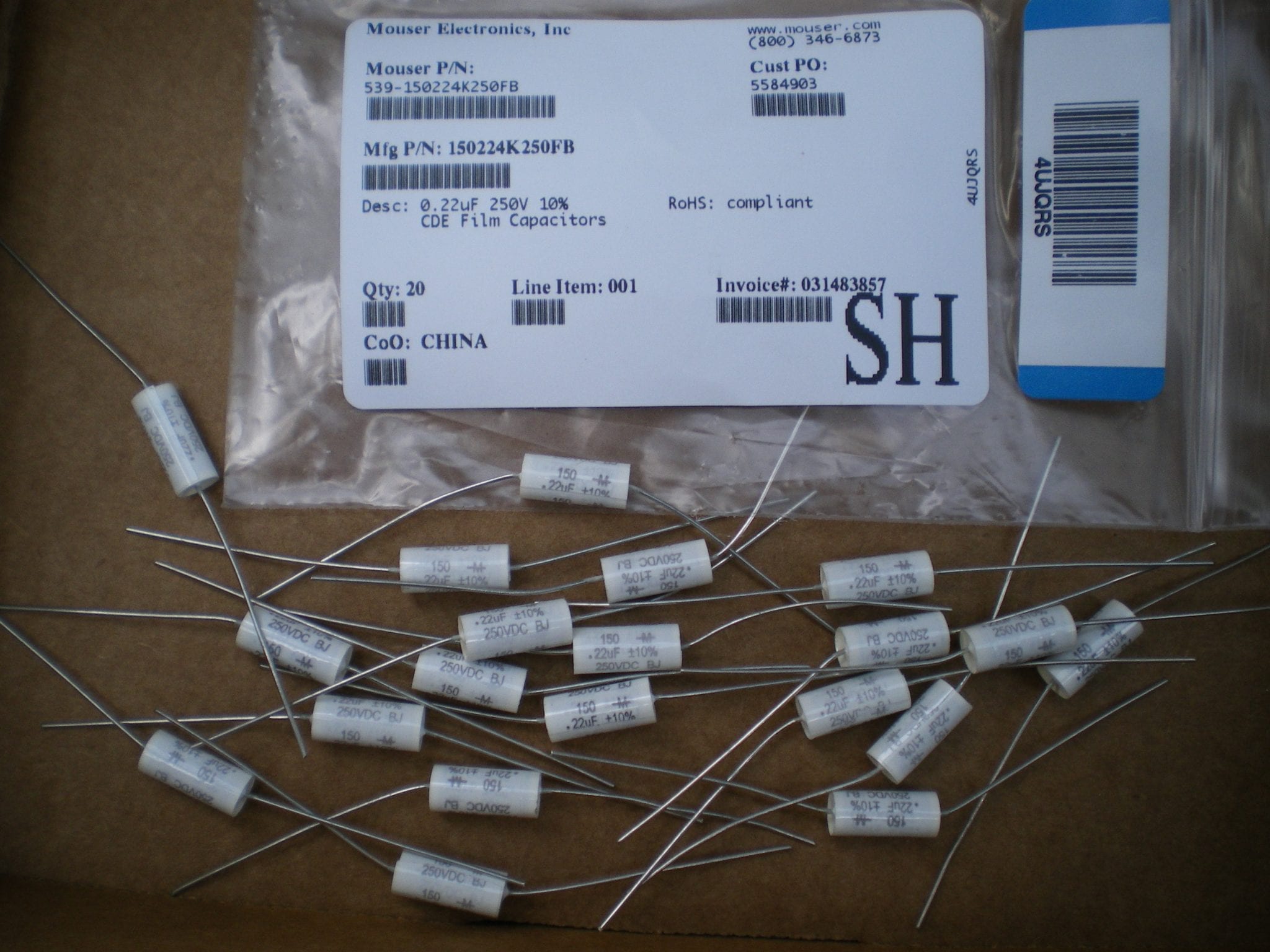Home › Forum › Ask A Member › Substituting capacitors for condensers
- This topic has 18 replies, 8 voices, and was last updated 5 years, 1 month ago by
 Mumbles.
Mumbles.
-
AuthorPosts
-
March 26, 2020 at 12:18 pm #198449
.
A "Boathouse Repair" is one that done without having tools or the skills to do it properly.
-
This reply was modified 4 years, 2 months ago by
 Tubs.
Tubs.
March 26, 2020 at 12:34 pm #198451Buck: The 1839HQ series are definitely known to work and be reliable.
If a cap fails, it shouldn’t make your motor quit instantly but the uF rating will shoot off the high end of the scale and the points will burn prematurely causing a miss. Test their rating again after running the motor for a while, maybe 20 minutes, again after one hour, and see if it has changed any.
When I started experimenting with caps, I bought a bunch from Mouser but they had a lower voltage rating and might have had a different composition than the Vishay HQ caps and they wouldn’t last. Now I have a bag of them collecting dust.
This tool has to be one of the best investments I’ve ever made as it identifies the item you are testing and gives an accurate reading in picofarads instead of microfarads. It will identify different types of transistors, diodes, resistors, and capacitors etc. I keep one in the house for working on vintage audio equipment and another one out in the garage as a dedicated outboard tool. Highly recommended!
March 26, 2020 at 12:53 pm #198456for testing why not mount the caps on the block and run wires into the mag then you wont have to pull the flywheel to check.
March 26, 2020 at 2:18 pm #198462Mumbles, it was the P12106-ND, little orange radial caps
that I’m worried about, and used a bunch of.I’ve only been using the listed axial caps now.
On my Flambeau project, I’ve adapted some B&S caps,
so I could terminate the wiring on the condenser as
the original Eisemann condenser….. will see how that works.Prepare to be boarded!
March 26, 2020 at 3:11 pm #198469The length of the leads affects performance. At least that’s what I noticed when I tried that.
T
March 27, 2020 at 10:44 am #198575I’ve put off ordering from digikey because they seem to have so few different uf sizes in the range we typically use. Am I missing something?
At the link below…..I see a 0.22uf and a 0.15uf. Nothing in between. Am I missing something?
Some of the Mercury mags call for 0.18uf…..
https://www.digikey.com/catalog/en/partgroup/1839-hq-series/3932?mpart=MKP1839422084HQ&vendor=56
Chuck
March 27, 2020 at 2:41 pm #198609I’ve put off ordering from digikey because they seem to have so few different uf sizes in the range we typically use. Am I missing something?
At the link below…..I see a 0.22uf and a 0.15uf. Nothing in between. Am I missing something?
Some of the Mercury mags call for 0.18uf…..
https://www.digikey.com/catalog/en/partgroup/1839-hq-series/3932?mpart=MKP1839422084HQ&vendor=56
Chuck
No. you’re not missing anything, that’s what Vishay has to offer in this series of caps. A .22 uF cap would be the logical choice for your Merc mag. Another option might be an Orange Drop cap but they are large and hard to fit. They are more suited for motors from the 20’s – 40’s which had lots of room under the flywheel.
https://www.ebay.ca/sch/newoldsound/m.html?_nkw=orange+drop
Here’s something I saved from the old blue boards explaining the P/N’s and applications of the MKP1839 caps. Thanks again Jeff!
I guess that’s not going to happen. Wordfence won’t let me attach the file. I’ll try it again later doing it another way.
-
This reply was modified 5 years, 1 month ago by
 Mumbles.
Mumbles.
March 27, 2020 at 2:58 pm #198612Mumbles; is this what you mean?
Here are some great caps at Vishay.com
MKP1839 4 22 08 4 hq =.22uF MKP1839422084hqmkp1839 4 27 08 4 hq =.27uF mkp1839427084hq
mkp1839 4 39 08 4 hq = .39uF mkp1839439084hq
mkp1839 4 10 08 4 hq = .10uF MKP1839410084HQ
mkp1839 4 20 08 4 hq = .20uF mkp1839420084hq
mkp1839 4 18 08 4 hq = .18uF mkp1839418084hq
mkp1839 4 15 08 4 hq = .15uF mkp1839415084hq
mkp1839 4 16 08 4 hq = .16uf mkp1839416084hqMarch 27, 2020 at 10:19 pm #198628Here’s the file in PDF which contains some info which Jeff R. posted here a few years ago.
-
This reply was modified 4 years, 2 months ago by
-
AuthorPosts
- You must be logged in to reply to this topic.


